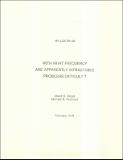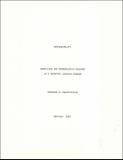Browsing Computer Science and Artificial Intelligence Lab (CSAIL) by Title
Now showing items 3780-3799 of 3804
-
Width-3 Permutation Branching Programs
(1985-12)We consider a restricted class of width-3 branching programs where each column of nodes depends on a single variable, and the 0-edges and the 1-edges out of each column form a permutation. In this model, parity and the ... -
WIRElist
(1969-01-01)This memo describes a design aid used for the automatic production of wirelists for machine or hand wiring of wire-cards. -
With what Frequency are Apparently Intractable Problems Difficult?
(1979-02)An algorithm is almost polynomial-time (apt) iff there is a polynomial p such that for all n, the algorithm halts within p(n) steps on all by at most p(n) inputs of size at most n. It is nown that for NP-complete and ... -
Workshop on the Design and Control of Dextrous Hands
(1982-04-01)The Workshop for the Design and Control of Dexterous Hands was held at the MIT Artificial Intelligence Laboratory on November 5-6, 1981. Outside experts were brought together to discuss four topics: kinematics of hands, ... -
Workstation Services and Kerberos Authentication at Project Athena
(1989-03)This document proposes solutions for two problems obstructing Project Athena's implementation of workstation services. The principal problem is that workstation services demand a more flexible mutual-authentication ... -
World Wide Web Without Walls
(2007-08-24)Today's Web is built upon a particular symbiotic relationship betweensites and users: the sites invest capital to create and market a setof features, and users gain access to the sites often in exchange fortheir data (e.g., ... -
Worms of Ganymedes - Hazards of Image "Restoration"
(MIT Artificial Intelligence Laboratory, 1980-09) -
Worst-case and Probabilistic Analysis of a Geometric Location Problem
(1980-02)We consider the problem of choosing K "medians" among n points on the Euclidean plane such that the sum of the distances from each of the n points to its closest median is minimized. We show that this problem is NP-complete. ... -
Wrist-Partitioned Inverse Kinematic Accelerations and Manipulator Dynamics
(1983-04-01)An efficient algorithm is presented for the calculation of the inverse kinematic accelerations for a 6 degree-of-freedom manipulator with a spherical wrist. The inverse kinematic calculation is shown to work synergistically ... -
Write Barrier Removal by Static Analysis
(2002-02) -
Writing and Representation
(MIT Artificial Intelligence Laboratory, 1988-09)This paper collects several notes I've written over the last year in an attempt to work through my dissatisfactions with the ideas about representation I was taught in school. Among these ideas are the notion of a 'world ... -
Wumpus Advisor 1: A First Implementation Program that Tutors Logical and Probabilistic Reasoning Skills
(1976-10-01)The Wumpus Advisor program offers advice to a player involved in choosing the best move in a game for which competence in dealing with incomplete and uncertain knowledge is required. The design and implementation of ... -
Wumpus Protocol Analysis
(MIT Artificial Intelligence Laboratory, 1977-08)The goal of this research was to assist in the creation of a new, improved Wumpus advisor by taking protocols of ten people learning to play Wumpus with a human coach. It was hoped that by observing these subjects learn ... -
Wusor II: A Computer Aided Instruction Program with Student Modelling Capabilities
(1977-05-01)Wusor II is the second program that has been developed to tutor students in the game of Wumpus. From the earlier efforts with Wusor I it was possible to produce a rule-based expert which processed a relatively complete ... -
The X Window System
(1986-10)An overview of the X Window System is presented, focusing on the system substrate and the low-level facilities provided to build applications and to manage the desktop. The system provides high-performance, high-level, ... -
X-Y Table User's Manual
(MIT Artificial Intelligence Laboratory, 1974-05)This working paper describes the mini-robot group's X-Y table and associated hardware. -
XGP Font Catalog
(MIT Artificial Intelligence Laboratory, 1974-05-24) -
XP. A Common Lisp Pretty Printing System
(1989-08-01)XP provides efficient and flexible support for pretty printing in Common Lisp. Its single greatest advantage is that it allows the full benefits of pretty printing to be obtained when printing data structures, as well ... -
XP. A Common Lisp Pretty Printing System
(1989-03-01)XP provides efficient and flexible support for pretty printing in Common Lisp. Its single greatest advantage is that it allows the full benefits of pretty printing to be obtained when printing data structures, as well ... -
The XPRT Description System
(MIT Artificial Intelligence Laboratory, 1979-01)This paper introduces a frame-based description language and studies methods for reasoning about problems using knowledge expressed in the language. The system is based on the metaphor of a society of communicating experts ...



















